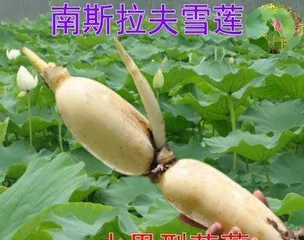As a common aquatic plant, lotus root is widely used in daily life. Planting lotus root in a home garden or farm is also a good choice. However, how can you grow healthy and robust lotus roots? This article will detail the planting methods and time for lotus root, and provide some useful tips and precautions to help readers create a bountiful garden.

I. Soil Preparation: Site Selection and Treatment
When selecting a planting site, prioritize a location with plenty of sunlight, good drainage, and soil rich in organic matter. Before cultivation, you can apply some organic fertilizer and use tools like plows and rakes to loosen the soil.
II. Seed Purchase and Storage
When purchasing lotus root seeds, choose reputable sellers with high-quality products. To maintain the quality of the seeds, store them in a dry, well-ventilated environment.

III. Soaking and Germination
Before planting lotus root, the seeds need to be soaked in clean water for a period to allow them to absorb water fully. Then, take the seeds out and let them dry for later use. The germination of lotus root seeds requires a certain temperature and humidity and can be done in a germination box.
IV. Seedbed Preparation
Before planting lotus root, a suitable seedbed for its growth needs to be prepared. You can choose a shallow pond or ditch as the seedbed, evenly sow the lotus root seeds on it, and cover with a layer of fine sand.
V. Transplanting Techniques
When the lotus seedlings have grown to a certain extent, they need to be transplanted to the field. When transplanting, be careful to avoid damaging the seedling roots and ensure they are arranged neatly.

VI. Fertilization and Watering
Lotus root requires a large amount of nutrients and water during its growth, so regular fertilization and watering are necessary. You can choose organic fertilizers and liquid fertilizers, paying attention to controlling the amount and frequency of application.
VII. Pest and Disease Control
During the growth process, lotus root is susceptible to various pests and diseases, such as downy mildew, anthracnose, and aphids. You should regularly inspect the lotus field to detect and treat pests and diseases in a timely manner.
VIII. Harvesting and Storage
The harvesting time for lotus root is usually in autumn, when the roots have grown to a suitable size. After harvesting, the roots should be cleaned, dried, and stored in a dry, well-ventilated place.
IX. Nutritional Value of Lotus Root
Lotus root is rich in various vitamins and minerals, which can enhance human immunity and prevent cancer and cardiovascular diseases. At the same time, lotus root also has effects such as clearing heat and detoxifying, moistening the lungs and relieving cough.
X. Planting Precautions
During the planting process of lotus root, attention should be paid to keeping the soil moist and avoiding temperatures that are too high or too low. At the same time, varieties with better shade tolerance should be selected to avoid sun exposure.
XI. Growth Cycle of Lotus Root
The growth cycle of lotus root is usually about half a year, requiring patience for the roots to mature. Throughout the entire growth cycle, timely management and care of the lotus root are necessary.
XII. Various Uses of Lotus Root
Lotus root can be used to make dishes, soups, desserts, etc., and has a wide range of uses. At the same time, lotus root can also be processed into foods such as lotus root powder and lotus root noodles.
XIII. Market Value of Lotus Root
As a common agricultural product, the market price of lotus root is very affordable. By planting lotus root, one can obtain good economic returns.
XIV. Cultivation Techniques for Lotus Root
During the cultivation of lotus root, attention should be paid to mastering some techniques, such as controlling temperature and selecting appropriate fertilizers, to improve the yield and quality of the lotus root.
XV.
By providing a detailed introduction to the planting methods and time for lotus root, it is hoped that readers can better master the skills and precautions for planting it. Whether in a home garden or a farm, planting lotus root is a good choice, and everyone can look forward to a bountiful harvest.